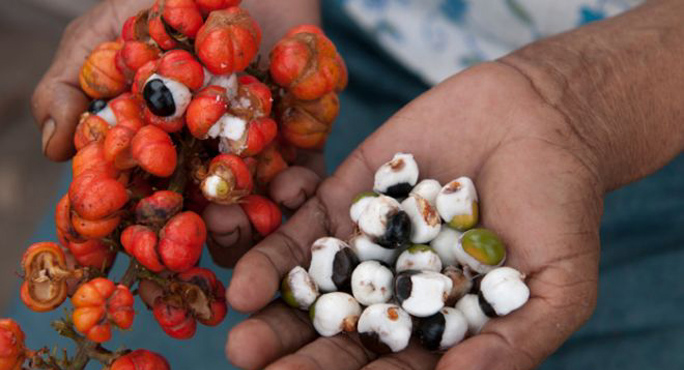Hands holding the Guarana fruit and the pulp of the Guarana
The name guarana derives from the Amazonian word “varana,” meaning a tree that grows on top of another. Guarana is the dried paste of the seeds of the climbing Amazonian evergreen liana Paullinia cupana, which is used primarily as a stimulant due to its caffeine content.
Typically the red seed of the plant is roasted, freed of its protective outer layer, crushed with water, and formed into a paste – which is then dried into sticks or blocks. The sticks, which store well for long periods of time, are scraped on a grater to yield guarana powder. In South America, guarana is used frequently in beverages, in the same way that kola nut is employed in the United States. However, while kola nut imparts a strong flavor, guarana is milder.
Guarana is widely employed as a stimulant, to relieve fatigue, to boost energy, aid concentration, and brighten mood. In dietary supplements, guarana is often used as a thermogenic (to boost metabolism for purposes of weight loss), and as an appetite suppressant. Guarana appears in tablets, capsules, and various fluid and dried extracts.
Guarana has traditionally been used among natives of Amazonia to prevent arteriosclerosis (hardening of arteries), to treat chronic diarrhea, as an aphrodisiac, stimulant, tonic and intoxicant (when smoked). It has also been employed to treat fevers and headache, rheumatism, lumbago, to reduce heat stress, and as a diuretic.
Interest in Amazonian products, along with the universal love of caffeine, have conspired to bring guarana to Europe and the United States. Though guarana enjoys its greatest popularity in South America, it has been employed in beverages and supplements in other areas.
Throughout the colonial occupation of Brazil, the various benefits of guarana became known to settlers. European researchers began studying Guarana in France and Germany in the 1940s, confirming Indian uses of guarana to cure fevers, headaches and cramps, and as an energy tonic.
In Manaus, the northernmost major city in the Brazilian Amazon, guarana stands are common and popular. There, guarana paste is added to blended drinks of various tropical fruits and is marketed as both a stimulant and an aphrodisiac.
Cultivated in hot, humid areas, guarana is slow growing. The plants first produce fruits, which each contain only one seed, after four years. Plantings become commercially viable after five years. The estimated yield of five hectares of guarana is approximately 2,000 kilograms of roasted seed, which is referred to as “rama.”
Guarana naturally contains between 2.5 to 7 percent of caffeine. It also contains modest amounts of the related compounds theophylline and theobromine. Caffeine stimulates the central nervous system and is a cortical stimulant, thus moblizing brain function. It stimulates the flow of blood in the brain and increases secretion of the important neurotransmitter serotonin.
Caffeine invigorates the mind, enhances alertness, facilitates thought formation and decreases fatigue. Overall it stimulates the cardiovascular system and increases cardiac output. Caffeine is also a mild diuretic and stimulates respiration, but mainly the drug inspires the weary, elevates the moderately depressed, and quickens the step of the tired.
Guarana is an accepted food ingredient throughout South America and North America and is used primarily as a stimulant in beverages. In France, guarana products may be marketed with claims for treatment of mild diarrhea, to treat functional asthenia (general debility or loss of strength), and as an adjunctive treatment for weight loss.
Guarana is a caffeine-based stimulant, and as such, people have varying levels of tolerance. Meta studies show that up to 300 miligrams of caffeine per day is generally safe and beneficial for most adults. Seek your own comfort level with guarana.


